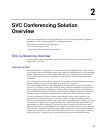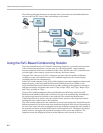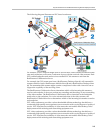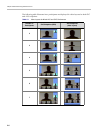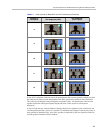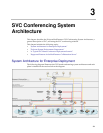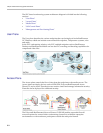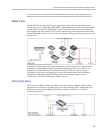
Chapter 2-SVC Conferencing Solution Overview
2-4
Some of the advantages of SVC conferencing are:
• Offers high-resolution video conferencing with low end-to-end latency, improved error
resiliency and higher system capacities.
• Allows the SVC-enabled video endpoints to manage display layouts, support multiple
resolutions and data rates. SVC provides simulcasting at different resolutions with
more layout building options on the endpoint. Flexible in-stream selection to
accommodate various endpoint capabilities such as bandwidth, CPU, screen resolution,
and so forth.
• The RealPresence Collaboration Server functions as a media relay server providing low
cost production benefits. The RealPresence Collaboration Server reduces bandwidth
usage by only selecting the necessary video stream to be sent to the endpoints.
Using SVC-Enabled Endpoints in a Mixed AVC and SVC
Conference
A transcoded CP (Continuous Presence) conference is also described as an AVC (Advanced
Video Coding) conference. All endpoints that do not support the H.264 SVC protocol such
as H.263, H.264, or RTV, are considered AVC endpoints.
The RealPresence Collaboration Server 800s - Virtual Edition, the industry’s first multi-
protocol, integrated software MCU that runs on industry-standard servers, can manage a
mixed SVC and AVC-based conference. This type of conference enables participants with
SVC-enabled endpoints and AVC endpoints to participate in the same conference.
SVC endpoints transmit multiple resolutions and temporal layers to the Collaboration
Server like the SVC-based conferences, while AVC endpoints send only one H.264 AVC
video stream to the Collaboration Server. The Collaboration Server relays SVC-decoded
video bit streams to the SVC-enabled endpoints in the conference according to their display
capabilities. This enables the video conference layouts to be automatically assembled by the
endpoint. AVC endpoints connected to the conference send a single H.264 AVC video bit
stream to the Collaboration Server, which is then transcoded to SVC video streams. SVC-
enabled endpoints receive the AVC converted video bit streams through the Collaboration
Server from the AVC endpoints as a single SVC video bit stream. Alternatively, AVC
endpoints receive a single video bit stream with the defined video conference layout from
the Collaboration Server. In this mixed mode conferencing, all AVC endpoints receive the
same CP video layout as an AVC Only conference, but SVC endpoints receive the same
video layout configuration as an SVC Only conference.








